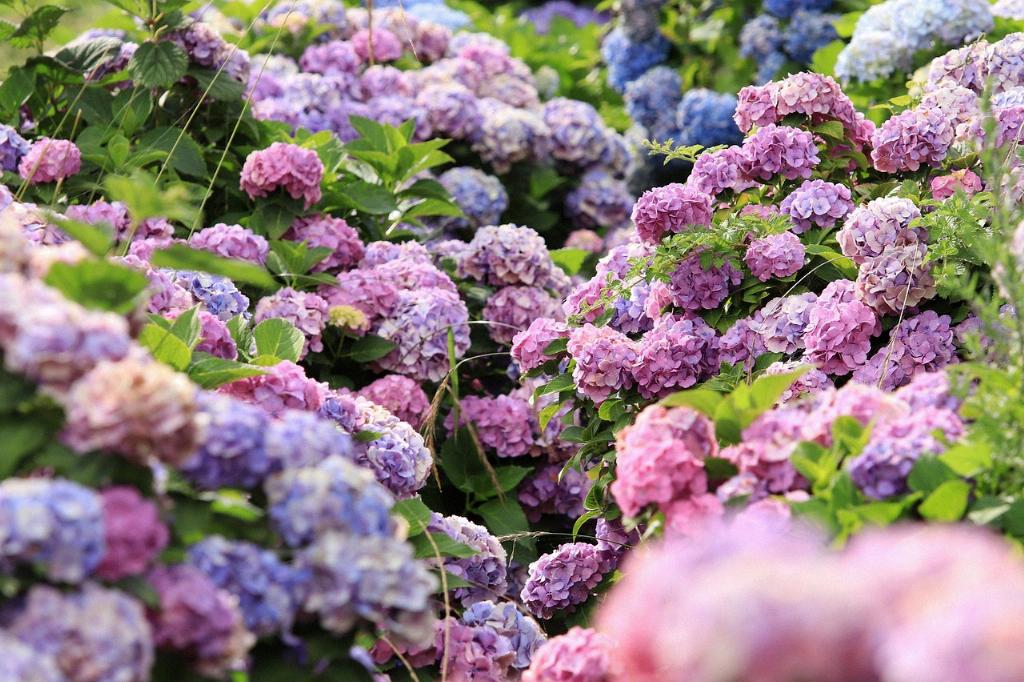Hydrangea trees are not just plants but a vivid spectacle that transforms your garden with waves of lush blooms. Unlike their bush counterparts, hydrangea trees, particularly the Paniculata species, are cultivated to stand on a single stem, similar to a small tree. These magnificent flora provide height and dramatic visual appeal, showcasing broad, showy flower heads that range from pure white to rich pinks and deep blues, depending on the variety and soil acidity. The unique character of hydrangea trees makes them an absolute must for anyone looking to add texture and interest to their landscape. Providing a burst of color from late spring through fall, they help extend the visual pleasure of your garden’s blooming season.
Selecting the Perfect Spot: Ideal Conditions for Hydrangea Trees
Choosing the right spot to plant a hydrangea tree is crucial for its growth and flourishing. These stately beauties thrive best in locations with morning sun and afternoon shade, which helps them avoid the stress from the midday heat. They prefer well-drained, fertile soils; however, I can’t stress enough the importance of ensuring the soil stays moist but not waterlogged. If you’re stuck with dense or clay-heavy soil, consider amending it or choose a raised bed to improve drainage. A well-chosen site is a considerable stride towards a thriving, vibrant hydrangea tree that will be the envy of the neighborhood.
Planting Your Hydrangea Tree: Step-by-Step Guide
Planting a hydrangea tree is a delightful affair! Early fall or spring is the ideal time for planting to allow roots to establish without the extremes of summer or winter. Start by digging a hole as deep as the root ball and twice as wide. This spacious approach ensures roots can spread without struggle. Introduce the tree to the hole so that the base of the trunk is level with the soil surface, then backfill with a mixture of the original soil and organic compost, which offers a buffet of nutrients for your young tree. A thorough initial watering will settle the soil around the roots, reducing air pockets and providing a moist environment to encourage growth.
Caring for Your Hydrangea Tree: Watering, Feeding, and Pruning Tips
Caring for hydrangea trees involves regular watering, especially during dry spells, to keep the soil consistently moist. Hydration is key, but avoid waterlogging to fend off root diseases. A balanced, slow-release fertilizer applied in early spring promotes lush foliage and vibrant blooms. When it comes to pruning, the objective is maintaining a nice shape and encouraging healthy growth. Prune in late winter or early spring before new growth begins, removing only dead wood and thinning out crowded areas to let light and air reach the inner branches. This combo of care keeps your hydrangea tree in peak condition, flaunting spectacular blooms season after season.
The Best Hydrangea Tree Varieties for Every Landscape
While there are numerous hydrangea varieties, a few stand out for their adaptability and visual appeal. The Paniculata ‘Grandiflora’, widely known as PeeGee, flourishes in most climates, sporting large white flowers that gradually change to pink. Another favorite is the ‘Limelight’, notable for its distinct lime-green blooms that transition to pink and burgundy in fall. For smaller spaces, the ‘Little Lime’ offers the same stunning visual impact in a more compact form. Each variety has its charm, ensuring there’s a perfect hydrangea tree for every landscape design.
Common Pests and Diseases Affecting Hydrangea Trees
Despite their hardiness, hydrangea trees are not immune to pests and diseases. Common issues include aphids, mites, and powdery mildew, which can usually be managed with proper care and timely intervention. Regularly inspecting the underside of leaves and keeping the area around the tree clean and free of debris can prevent many problems. If pests or mildew take hold, organic options like neem oil or a mild soap solution can be effective treatments that help keep your plants healthy and your garden eco-friendly.
Seasonal Care: Preparing Your Hydrangea Tree for Winter
As cooler weather approaches, preparing your hydrangea tree for winter is critical, especially in regions where temperatures drop below freezing. This involves applying a layer of mulch around the base to insulate the roots. However, wait until the first frost has passed to avoid trapping warmth in the soil, which can lead to premature growth. Ensuring your hydrangea tree has sufficient moisture before the ground freezes can make the difference between a tree that merely survives winter and one that thrives year after year.
Hydrangea Trees: Frequently Asked Questions
How often should I water my hydrangea tree? Water deeply 3 times a week during summer, less frequently during cooler months.
Can I grow a hydrangea tree in a pot? Yes, especially smaller varieties like ‘Little Lime’. Ensure the pot has good drainage.
When is the best time to prune a hydrangea tree? Late winter or early spring, before new growth starts.
Conclusion: Enjoying the Beauty of Hydrangea Trees Year-Round
Wrapping up, hydrangea trees are not just another flowering tree; they’re a cornerstone for year-round garden aesthetics. With the right care, these trees can provide breathtaking blooms and a robust presence in any garden. From the joy of seeing new buds in spring to the rich, mature colors of autumn leaves, enjoy the dynamic beauty of hydrangea trees through the seasons. They’re not just plants; they’re a long-term investment in the beauty and vitality of your outdoor space.

